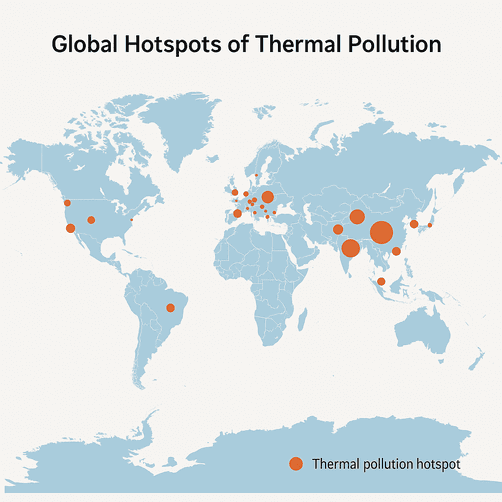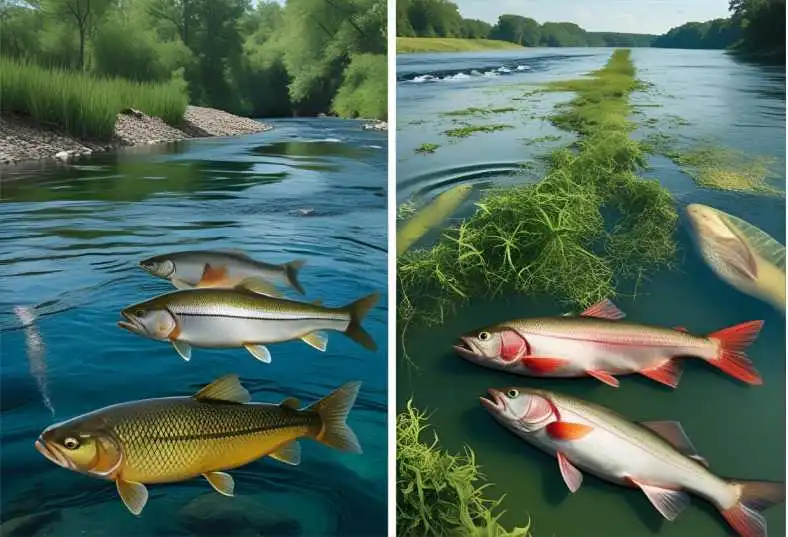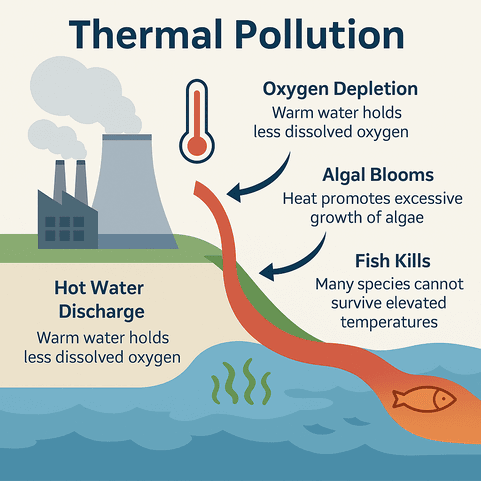Introduction:
In 2023, Florida’s Turkey Point Nuclear Plant made headlines for all the wrong reasons. It’s 95°F wastewater discharge killed 80% of juvenile mangroves in Biscayne Bay—an ecological disaster that left coastlines weakened and communities alarmed.
Unlike chemical spills, which you can see and smell, this “silent killer” is harder to detect. Thermal pollution happens when human activities heat waterways far beyond their natural temperatures, setting off a chain reaction of fish die-offs, toxic algae blooms, and climate feedback loops.

Table of Contents
The 5 Biggest Causes of Thermal Pollution (and Why They Matter)
Thermal pollution arises from various human activities. Here are the top five contributors:
Thermal Pollution Causes & Impacts
| Source | Temp Increase | Key Fact |
| Power Plants | +10-15°F | #1 cause (70% of artificial heat – EPA 2024) |
| Urban Runoff | +12°F | Pavement heats stormwater (NOAA 2023) |
| Deforestation | +5-8°F | Loss of shade increases stream No shade = hotter streams |
| Factory Discharge | Extreme | Steel mills dump boiling wastewater |
| Reservoirs | 30% faster heating | Stagnant water traps heat (USGS) |
Shocking Case: The Ohio River hit 93°F near a coal plant – deadly for trout that need cool water.
1. Power Plants: Overheating Ecosystems
Power plants are the leading source of thermal pollution, contributing over 70% of artificial heat discharge (EPA, 2024). Coal, nuclear, and natural gas plants use water for cooling and then release it 10–15°F hotter than natural temperatures. In 2022, the Ohio River recorded 93°F near a coal plant, lethal for cold-water fish like trout.
2. Urban Runoff: Heat from Asphalt
Urban runoff is another major source of thermal pollution. Dark asphalt absorbs heat, causing stormwater temperatures to rise by as much as 12°F (NOAA, 2023). This heated runoff can enter nearby rivers, raising water temperatures and disrupting local ecosystems.
3. Deforestation: Loss of Natural Shade
Deforestation removes shade, raising stream temperatures by 5–8°F (Journal of Hydrology, 2023). The loss of tree cover exposes water bodies to direct sunlight, worsening thermal pollution.

4. Industrial Waste: Scorching Effluent
Steel mills, refineries, and other industrial plants discharge hot water as part of their manufacturing processes. This “effluent” significantly raises local water temperatures, further stressing aquatic ecosystems.
5. Reservoirs: Slower Water Movement
Unlike fast-moving rivers, reservoirs heat up 30% faster (USGS). With slower water flow, thermal pollution accumulates, further endangering fish and aquatic life.
To learn more about thermal pollution causes, check this detailed guide.
The Devastating Effects of Thermal Pollution on Marine Life and Climate
Aquatic Apocalypse: How Hot Water Kills
Even a slight rise in water temperature can unleash a chain reaction of ecological disasters. Picture this: fish gasping for oxygen, coral reefs bleaching into ghostly white skeletons, and toxic algae choking entire river systems.
Here’s how warm water quietly destroys aquatic life:
✅ Suffocation: Warm water holds 40% less oxygen, suffocating fish and invertebrates.
✅ Toxic Overload: Heat fuels flesh-eating algae blooms like Florida’s 2023 red tide.
✅ Reproductive Collapse: Salmon can’t spawn above 86°F, threatening entire food webs.

Case Study: Florida’s 95°F wastewater killed 80% of juvenile mangroves in 2023. This led to weakened coastlines and increased hurricane damage.
Why a 3°C Rise Threatens Fish Survival
Coral reefs bleach above 86°F (EPA Coral Reef Watch, 2023), making it harder for aquatic life to survive. The combination of oxygen depletion and heat accelerates the growth of toxic algae, which can lead to harmful algal blooms.
- Salmon lose their spawning ability (NOAA, 2024).
- Zooplankton crashes, starving marine food webs.
Additional Environmental Impacts
- Climate Feedback Loops: Warmer waters release trapped CO₂, accelerating global warming.
- Oxygen Depletion: Less oxygen stresses fish and aquatic plants.
- Toxic Algae Growth: Cyanobacterial blooms can poison drinking water.
- To learn more about thermal pollution effects, check this detailed guide.
7 Real-World Solutions to Stop Thermal Pollution
Tackling thermal pollution takes more than awareness—it requires practical solutions and policy change. Below are seven strategies that communities, industries, and policymakers can start using today:
1. Cooling Towers: Closed-Loop Systems
Mandate the use of closed-loop cooling systems in power plants to reduce the temperature of discharged water. Cooling towers help maintain cooler water and prevent overheating.

2. Artificial Wetlands: Nature’s Cooling Solution
Artificial wetlands, like the pilot project in Miami, can reduce water temperatures by as much as 11°F. These wetlands use plants to absorb heat and filter water before it enters natural bodies.
3. Shade Restoration: Replanting Riverside Trees
Replanting trees along riverbanks can help restore shade and lower water temperatures by up to 6°F (USDA). This natural solution also improves biodiversity and helps prevent erosion.
4. Permit Reforms: Limit Discharge Temperatures
Governments should enforce stricter regulations on the temperatures of industrial discharge. For example, proposed EPA rules limit discharge temperatures to 90°F to protect aquatic life.
5. Green Roofs: Combat Urban Heat Islands
Green roofs and other urban greenery can help reduce the heat island effect in cities, lowering the overall temperature of surrounding areas and reducing thermal runoff.
- Permeable Pavements – These reduce heat absorption and prevent overheated stormwater from entering rivers.
Cool Roofs & Reflective Surfaces – Buildings with reflective materials can lower city-wide temperatures and minimize heat runoff. - Stormwater Retention Ponds – Collect and slowly release water to prevent heat spikes in natural bodies.
6. Thermal Barriers: Floating Solar Panels
Installing floating solar panels on bodies of water can create a barrier that blocks excess heat while generating clean energy.
7. Public Pressure: ISO 14001 Standards
Encourage industries to adopt ISO 14001 standards for environmental management, which can help reduce heat emissions and prevent thermal pollution.
FAQ: Thermal Pollution Explained
Q: What is an example of thermal pollution in real life?
A: A real-life example of thermal pollution is the Turkey Point Nuclear Plant in Florida. In 2023, it released 95°F wastewater into Biscayne Bay, killing 80% of juvenile mangroves and disrupting the entire coastal ecosystem.
Q: How does thermal pollution affect aquatic life?
A: Thermal pollution reduces oxygen levels in water, causing fish and invertebrates to suffocate. It also disrupts spawning cycles, accelerates algae blooms, and can kill sensitive species like salmon and coral reefs
Q: What is the biggest source of thermal pollution today?
A: Power plants are the largest source of thermal pollution globally. Coal, gas, and nuclear plants use water for cooling, then discharge it at higher temperatures, damaging nearby rivers and lakes
Q: How can we reduce thermal pollution from industries?
A: Thermal pollution can be reduced through cooling towers, closed-loop water systems, reforestation near water bodies, stricter discharge permits, and adoption of ISO 14001 environmental standards.
Q: Why is thermal pollution worse in summer?
A: In summer, higher air temperatures already heat water naturally. Industrial discharges on top of that cause extreme temperature spikes, increasing fish deaths, algae growth, and water quality degradation.
Q: Does thermal pollution contribute to climate change?
A: Yes, indirectly. Heated water bodies release trapped CO₂ and methane, both of which are greenhouse gases. Thermal pollution can also reduce carbon sinks like mangroves and wetlands.
Q: Can green roofs and permeable pavements help stop thermal pollution?
A: Yes, urban infrastructure like green roofs, permeable pavements, and stormwater ponds reduces heat runoff, lowers surrounding temperatures, and prevents overheated water from reaching rivers.
Q: What temperature is dangerous for freshwater fish?
A: Most freshwater species become stressed above 77°F (25°C), and many, like trout and salmon, cannot survive or reproduce if water temperatures exceed 86°F (30°C).
Take Action: Join the Fight Against Thermal Pollution
Thermal pollution is a growing crisis requiring immediate action. Support policies like closed-loop cooling systems and mangrove restoration to protect ecosystems.
Sign the petition urging the EPA to enforce stricter cooling regulations!
Your voice matters! Join the Movement to Stop Thermal Pollution
Your voice matters. Support policies that protect our rivers, wetlands, and marine life.
Vote for the solution you believe will make the biggest impact:
- Cooling towers at every power plant
- Nationwide mangrove restoration
- Criminal penalties for illegal discharges
[Sign this EPA petition to enforce stricter regulations.]
Share this article to spread awareness!
Want to learn more about how thermal pollution affects our environment?
- Thermal Pollution: Causes, Effects & Solutions
- Effects of Thermal Pollution on Aquatic Ecosystems
- Solutions to Thermal Pollution
About the Author
Soumen Chakraborty is an environmental writer and researcher dedicated to making sustainability accessible to everyone. With a background in environmental studies and two years of experience simplifying complex topics, he aims to inspire action through clear, engaging content.
Want to connect or collaborate? [Contact Soumen here].
Last updated: 1st July 2025.
“Every small action matters in protecting our planet.”

